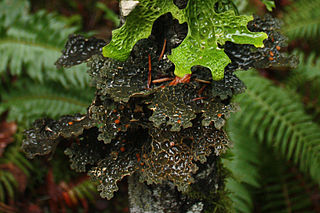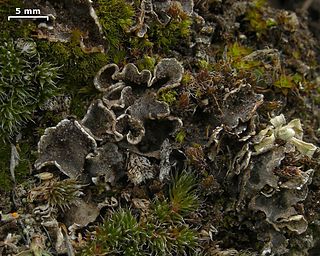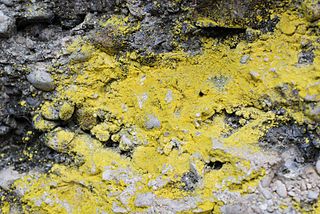
Peltigera is a genus of approximately 100 species of foliose lichens in the family Peltigeraceae. Commonly known as the dog or pelt lichens, species of Peltigera are often terricolous, but can also occur on moss, trees, rocks, and many other substrates in many parts of the world.

The Peltigeraceae are a family of lichens in the order Peltigerales. The Peltigeraceae, which contains 15 genera and about 600 species, has recently (2018) been emended to include the families Lobariaceae and Nephromataceae. Many Peltigeraceae species have large and conspicuous, leathery thalli. They largely occur in cool-temperate to tropical montane climates. Tripartite thalli involving fungus, green algae and cyanobacteria are common in this family.

Sticta is a genus of lichens in the family Peltigeraceae. The genus has a widespread distribution, especially in tropical areas, and includes about 114 species. These lichens have a leafy appearance, and are colored brown or black. Sticta species with cyanobacteria as photobionts can fix nitrogen from the atmosphere, and due to their relative abundance and high turnover, they contribute appreciably to the rainforest ecosystem. They are commonly called spotted felt lichens.

Pseudocyphellaria is a genus of large, leafy lichens that are sometimes referred to as "specklebelly" lichens. The genus has a widespread distribution, especially in south temperate regions, and contains about 170 species. They resemble Lobaria, except that most species of Pseudocyphellaria have conspicuous pseudocyphellae on their lower surface, a characteristic that was once considered unique to this genus. Some species contain pulvinic acid-related pigments; in these species the soredia and pseudocyphellae can be bright yellow.
Cora hirsuta is a species of basidiolichen in the family Hygrophoraceae. Found in the páramo region near Bogotá at over 3,000 m (9,800 ft) elevation, it was described as new to science in 2011. The lichen, characterised by its distinctively hairy upper surface and smaller lobes, thrives in a variety of habitats, including soil, bryophytes, and as epiphytes on trees.
Sticta venosa is a species of terricolous (ground-dwelling), foliose lichen in the family Peltigeraceae. It is known only from Pichincha Province, Ecuador, and from Colombia. It was described as new to science in 2011.

Peltigera lepidophora, commonly known as the scaly pelt, is a species of foliose lichen in the family Peltigeraceae. It was first described by Finnish lichenologist Edvard August Vainio in 1878 as a variety of Peltigera canina. German botanist Friedrich August Georg Bitter promoted it to species status in 1904.

Allographa leptospora is a species of script lichen in the family Graphidaceae. The lichen was first formally described in 1921 by Finnish lichenologist Edvard August Vainio as Graphis leptospora. The type specimen was collected in 1904 by German botanist Carl Curt Hosseus on Doi Suthep, where it was found growing on tree bark. Hosseus sent this and other lichens collected from Thailand to Vainio for identification. Robert Lücking and Klaus Kalb transferred it to the genus Allographa in 2018. In 2016, the lichen was reported from the Sintra Mountains, Portugal, which was its first documented occurrence in Europe.
Cora cyphellifera is a species of basidiolichen in the family Hygrophoraceae. Found in northern Ecuador, it was formally described as a new species in 2013 by Manuela Dal-Forno, Frank Bungartz, and Robert Lücking. The type specimen was collected near the entrance to the Alto Choco Reserve at an elevation of 2,053 m (6,736 ft). Here, in open, disturbed forest patches, the lichen grows as an epiphyte on tree branches and twigs, forming foliose, light bluish-green thalli up to 15 cm (6 in) across, and comprising 20 to 30 semicircular lobes in each thallus. Cora cyphellifera is only known to occur at the type locality, which is a montane rainforest. The specific epithet refers to the unusual cyphelloid structure of the thallus; this characteristic is otherwise unknown in the genus Cora. According to the authors, "it almost looks like the lichenized thallus is parasitized by a non-lichenized, cyphelloid mushroom".
Cora undulata is a species of basidiolichen in the family Hygrophoraceae. Found in Colombia, it was formally described as a new species in 2014 by Leidy Yasmín Vargas, Bibiana Moncada, and Robert Lücking. The type specimen was collected in Finca El Paraiso at an altitude of 1,400 m (4,600 ft). The lichen is only known to occur at the type locality, where it grows on rocks, often associated with bryophytes in semi-exposed microhabitats. Its dark olive-green thalli are foliose, measuring up to 9 cm (3.5 in) and comprising 5 to 15 semicircular lobes. The specific epithet undulata refers to the undulate (wavy) surface of the lobes.
Sticta densiphyllidiata is a species of foliose lichen in the family Peltigeraceae. Found in Puerto Rico, it was formally described as a new species in 2020 by Joel Mercado‐Díaz and Robert Lücking. The type specimen was collected by the authors along a trail in El Yunque National Forest, at an altitude of 909 m (2,982 ft).The lichen is common in the rainforests on the eastern part of the island, where it thrives in humid and shaded habitats. It grows on rocks but the authors note that it could also grow as an epiphyte. The specific epithet densiphyllidiata refers to the dense distribution of branched phyllidia that occur along the margins of the lobes.
Sticta rhizinata is a species of foliose lichen in the family Peltigeraceae. Found in Colombia, it was formally described by Bibiana Moncada and Robert Lücking in 2012. It is a member of the Sticta weigelii species complex. The type specimen was collected in Chingaza National Natural Park (Cundinamarca) at an altitude of 3,430 m (11,250 ft). The lichen is only known to occur in the Andes of Colombia at altitudes between 2,300 and 3,720 m. Here it grows on the ground, often associated with bryophytes of the genera Plagiochila, Frullania, Metzgeria, Campylopus, and Dicranum. Frequent lichen associates include Everniastrum, Hypotrachyna, and Peltigera. The specific epithet rhizinata refers to its conspicuous rhizines.
Yoshimuriella is a genus of foliose (leafy) lichens in the family Peltigeraceae. It has nine species.
Peltigera wulingensis is a species of terricolous (ground-dwelling), foliose lichen in the family Peltigeraceae. Originally described from specimens found in northern China, it has since been recorded in Canada, Norway, and Russia.

Crocodia is a genus of foliose lichens in the family Peltigeraceae. It has eight species. The genus has a cosmopolitan distribution, although most species occur in temperate and tropical regions of the Southern Hemisphere. The main characteristics of the genus that separate it from its parent genus, Pseudocyphellaria, include a yellow medulla and yellow pseudocyphellae on the lower thallus surface.

Dendriscosticta is a genus of foliose lichens in the family Peltigeraceae. The genus was circumscribed in 2013 by lichenologists Bibiana Moncada and Robert Lücking with Dendriscosticta wrightii assigned as the type species. The genus, a segregate of Sticta, was created to contain species in the Sticta wrightii clade. Dendriscosticta has a sister taxon relationship with the genera Yoshimuriella and Lobariella. Dendriscosticta is distinguished from Sticta by the presence of algae in the excipulum.
Sticta aongstroemii is a species of corticolous (bark-dwelling, foliose lichen in the family Peltigeraceae. It is found in the southern part of the Atlantic Forest of Brazil.
Sticta atroandensis is a species of foliose lichen in the family Peltigeraceae. It is found in the Colombian Andes.
Sticta viviana is a species of corticolous (bark-dwelling), foliose lichen in the family Peltigeraceae. It is found in Colombia, where it grows on the branches and twigs of shrubs and treelets in high-elevation páramo habitat.

Leproplaca chrysodeta is a species of saxicolous (rock-dwelling) dust lichen in the family Teloschistaceae. It is found in Europe, the Middle East, and New Zealand.








